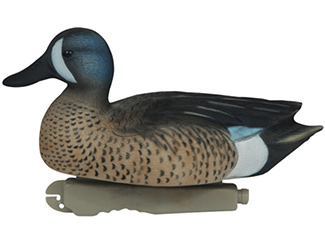 Well, it is that time of year again! Teal season in Texas has come and gone giving us waterfowl hunters a nice little teaser. If you duck hunt in Texas, then you have a little over a month to be prepared for the real deal! Now is a great time to think about buying duck decoys if you don’t have any or yours needs to be replaced. Several of you will likely paint and repair your old ones, but if you are like me, there is something about decoy shopping that I like. I would like to share with you a few things I have learned over the last 34 duck seasons.
Well, it is that time of year again! Teal season in Texas has come and gone giving us waterfowl hunters a nice little teaser. If you duck hunt in Texas, then you have a little over a month to be prepared for the real deal! Now is a great time to think about buying duck decoys if you don’t have any or yours needs to be replaced. Several of you will likely paint and repair your old ones, but if you are like me, there is something about decoy shopping that I like. I would like to share with you a few things I have learned over the last 34 duck seasons.
1. You get what you pay for!
This unfortunately is true for most things in life! Real cheap decoys are just that….. Real cheap! They will not last, the paint will chip, they will crack, and the super cheap ones will turn on their sides in heavy wind. Before buying a cheap duck decoy, pay attention to the thickness, durability, and overall paint finish. I understand that money gets tight and if that is the case, I encourage you to buy a few good ones instead of dozens of cheap ones or just repair your old ones. Take my advice on this one. This is coming from first hand experience!
2. Pay attention to the keel.
Duck decoys will, for the most part, come with two options: weighted keel or water keel. The weighted keel will never land on their side causing you to have to go turn them right side up. I also personally like the way the weighted keel ride in the water. However, if you are packing dozens in on your back I don’t think they are the way to go because water keel are much lighter. My main consideration on keels is this: if you walk to your blind, use the water keel. If you use a boat or vehicle to carry them, go with the weighted keel.
3. Cork, foam filled, or standard?
This is really a matter of opinion. A great foam or cork decoy wrapped in burlap will last you the rest of your life! A standard plastic decoy will have more feather detail and be more realistic. Foam filled plastic decoys will be a combination of the two, although they won’t last quite as long as burlap wrapped cork decoys and will float differently as well. I recommend, before spending piles of cash, that you get one of each type and do a float test to see which looks most realistic.
4. Species is important!
Birds of a feather flock together! I encourage you to buy the decoys that match what you hunt. In our area, there are lots of teal, gadwall, spoonbills, and ring necks. Therefore, my spread will consist of these types of decoys. I also really encourage you to buy several coot decoys if you hunt an area that has coot. The ducks are very comfortable when coot are present and sometimes a late season spread with mainly coot works better than anything else.
5. Decoy weights.
Unless you are hunting on land, which I never have where I hunt, you will need some decoy weights. I have two words for you on this subject…TEXAS RIG! Hands down, this set up has to be one of the best decoy inventions. No more need to wrap line around the head and no more tangled mess! You might not even need a decoy back depending on your situation. You simply clip them on a carabiner and go! (sorry deep water duck hunters…this won’t work for you!)
I hope this helps you make a great decision when buying duck decoys and I hope that you have a great duck season this year! At Duck Dog Trainer, we hope you remember to give thanks to the One who gives us the ducks!





